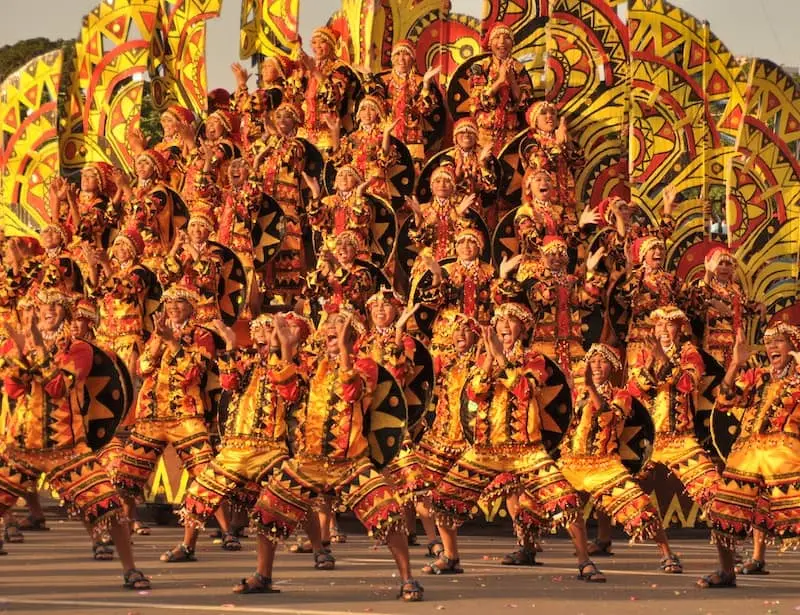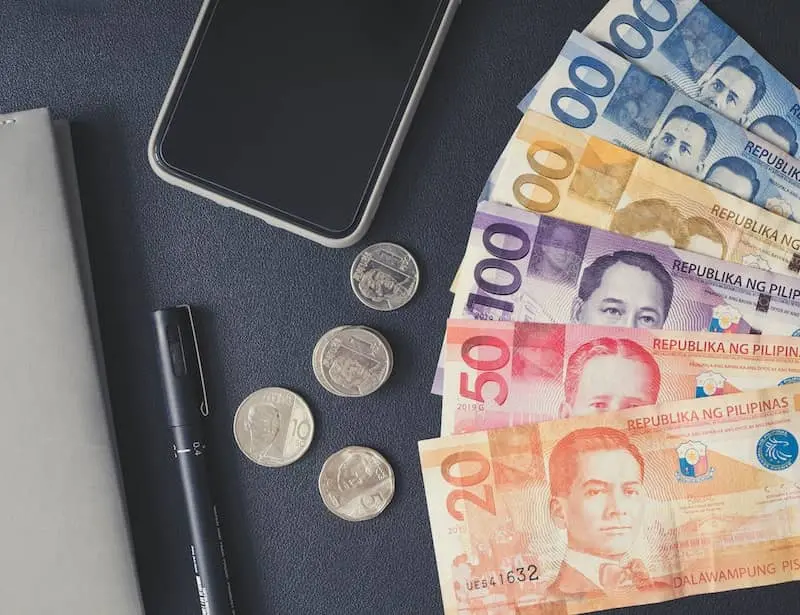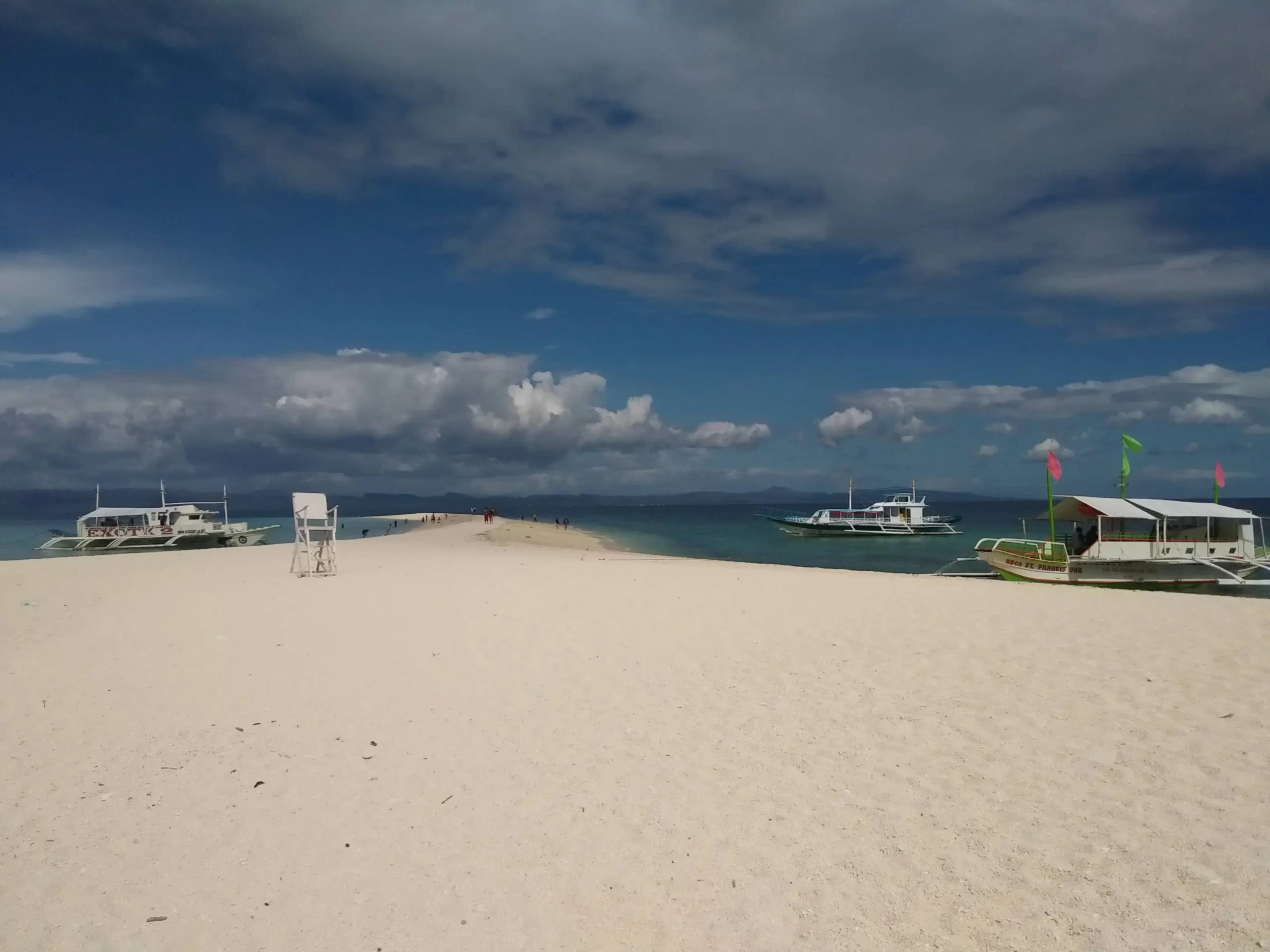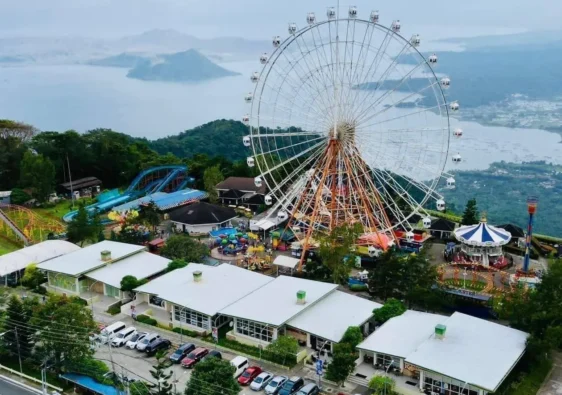Disclaimer: Some of the links in this website are affiliate links. This means we will earn a commission if you decide to book through our links, at no additional cost to you. This helps us to continue sharing useful guides and stories on this blog. Thank you for your support!
The Philippines’ climate is tropical and maritime, with relatively high temperatures and humidity throughout the year. The country experiences two distinct seasons: the dry season, which runs from November to April, and the wet season, which lasts from May to October. Continue down below to discover when is the best time to travel the Philippines.
Related reading: Philippines Travel Requirements: What Documents Do I Need To Travel To The Philippines
Philippines Climate Guide
The dry season is characterized by sunny weather and cooler temperatures, while the wet season brings heavy rainfall and occasional typhoons. The country’s eastern side, facing the Pacific Ocean, is particularly susceptible to typhoons, which can cause significant damage and disruption.
| Destination | Jan | Feb | Mar | Apr | May | Jun | Jul | Aug | Sep | Oct | Nov | Dec |
|---|---|---|---|---|---|---|---|---|---|---|---|---|
| Boracay | 26°C | 26°C | 27°C | 28°C | 29°C | 29°C | 28°C | 28°C | 28°C | 28°C | 27°C | 26°C |
| Palawan | 28°C | 28°C | 29°C | 30°C | 31°C | 31°C | 30°C | 30°C | 30°C | 30°C | 29°C | 28°C |
| Bohol | 28°C | 28°C | 29°C | 30°C | 31°C | 31°C | 30°C | 30°C | 30°C | 30°C | 29°C | 28°C |
| Cebu | 27°C | 27°C | 28°C | 29°C | 30°C | 30°C | 29°C | 29°C | 29°C | 29°C | 28°C | 27°C |
| Siargao | 27°C | 27°C | 28°C | 29°C | 29°C | 29°C | 28°C | 28°C | 28°C | 28°C | 28°C | 27°C |
| Baguio | 16°C | 16°C | 17°C | 19°C | 20°C | 19°C | 18°C | 18°C | 19°C | 19°C | 18°C | 17°C |
| Manila | 27°C | 27°C | 28°C | 30°C | 31°C | 30°C | 29°C | 29°C | 29°C | 29°C | 28°C | 27°C |
| Davao | 28°C | 28°C | 28°C | 30°C | 29°C | 30°C | 30°C | 29°C | 29°C | 29°C | 29°C | 28°C |
Typhoons in The Philippines
As someone who lives right in front of the Pacific Ocean, I personally experienced the whip of the super typhoon Haiyan (local: Yolanda) that hit the country last November 2013 since the eastern part of the country is prone to typhoons.
In fact, the Philippines has the most typhoons that traverse the responsibility area of the country, averaging 20 tropical cyclones.
The typhoon season in the Philippines typically starts in June and lasts until December, with the months of October and November often experiencing the most frequent and strongest typhoons. Being prepared and staying informed is crucial during this time, as typhoons can cause significant damage and disruption to travel plans.
Events and Festivals in The Philippines Month-by-Month

Below are the events and festivals you should witness every year if you want to somehow immerse yourself in the Philippines’ culture. Check out below, and discover which month is the best time to travel Philippines month-by-month.
January:
- The Feast of the Black Nazarene (January 9) is celebrated in Manila, a religious procession where thousands of devotees carry a life-sized statue of Jesus Christ.
- Sinulog Festival (3rd Sunday of January) in Cebu is a colorful celebration honoring the Santo Niño (Holy Child).

February:
- Panagbenga Festival (February 1-28) in Baguio is a month-long flower festival featuring parades, street dancing, and competitions.
- Chinese New Year (Lunar New Year) is celebrated in various parts of the country with dragon dances, fireworks, and traditional Chinese food.
March:
- Pahiyas Festival (May 15) in Lucban, Quezon, is a harvest festival where houses are decorated with colorful kiping (rice wafers) and other farm produce.
- Moriones Festival (Holy Week) in Marinduque is a reenactment of the story of Longinus, the Roman soldier who pierced Jesus Christ’s side with a spear.
April:
- Aliwan Fiesta (last weekend of April) in Manila, a grand parade and competition showcasing various regional festivals and cultural performances.
- Panaad sa Negros Festival (April 19-26) in Bacolod is a week-long celebration of the Negros Occidental province’s culture, history, and products.
May:
- Flores de Mayo (May 1-31) nationwide, a month-long tribute to the Virgin Mary featuring flower offerings, processions, and religious ceremonies.
- Obando Fertility Rites (May 17-19) in Obando, Bulacan, a three-day event where couples dance to pray for fertility and a happy marriage.
June:
- Independence Day (June 12), a national holiday commemorating the country’s independence from Spanish colonial rule in 1898.
- Parada ng Lechon (June 24) in Balayan, Batangas, a parade of roasted pigs (lechon) in honor of St. John the Baptist.
July:
- T’nalak Festival (July 18-20) in South Cotabato, a celebration of the T’boli tribe’s culture and traditions, highlighted by a street dancing competition.
- Sandugo Festival (July 1-31) in Bohol, commemorates the blood compact between Spanish explorer Miguel Lopez de Legazpi and Bohol chieftain Datu Sikatuna in 1565.
August:
- Kadayawan Festival (August 10-19) in Davao City, a week-long thanksgiving celebration of the city’s bountiful harvest and diverse cultural heritage.
- Buwan ng Wika (National Language Month), a month-long celebration of the Filipino language and culture, with various activities and competitions.
September:
- Feast of San Lorenzo Ruiz (September 28) in Manila, honoring the first Filipino saint with a procession and religious activities.
- MassKara Festival (3rd weekend of September) in Bacolod, a colorful and upbeat celebration showcasing the city’s resilience and optimism.
October:
- Lanzones Festival (3rd week of October) in Camiguin, a week-long celebration of the province’s sweet and juicy lanzones fruit, with parades, street dancing, and beauty pageants.
- Higantes Festival (November 22-23) in Angono, Rizal, featuring giant paper-mache figures (higantes) parading around the town to commemorate San Clemente, the town’s patron saint.
November:
- All Saints’ Day (November 1) and All Souls’ Day (November 2), when Filipinos visit cemeteries to remember and honor their departed loved ones.
- Kaamulan Festival (2nd week of November) in Malaybalay, Bukidnon, a week-long celebration of the province’s seven ethnic groups, featuring traditional dances, music, and food.
- Masskara Festival (November 5-6) in San Jose, Occidental Mindoro, a street dancing competition showcasing the province’s culture and history.
December:
- The Christmas season (December 1-31), the most festive and celebrated time of the year in the Philippines, is marked by colorful decorations, carol singing, gift-giving, and family reunions.
- Simbang Gabi (December 16-24), a nine-day pre-dawn Mass leading up to Christmas Eve, where Filipinos attend church and partake in traditional Filipino delicacies sold outside the church.
- Giant Lantern Festival (December 15-24) in San Fernando, Pampanga, a competition of giant, colorful lanterns called parol, showcasing the province’s talent in craftsmanship and design.
Popular Things to do in The Philippines

The Philippines is a diverse and beautiful country with many things to see and do. Here are some popular things to do in the Philippines:
Explore the Beaches
The Philippines is home to some of the most beautiful beaches in the world. From Boracay to Palawan, there are plenty of white sand beaches with crystal-clear waters that are perfect for swimming, snorkeling, or just lounging around.
Visit Historical Landmarks
The Philippines has a rich history, and there are many historical landmarks to explore. From the walled city of Intramuros in Manila to the ancient rice terraces of Banaue, there is something for everyone.
Go Island Hopping
The Philippines is an archipelago of over 7,000 islands, so island hopping is a must-do activity. From the popular islands of Boracay and Palawan to the lesser-known islands of Siargao and Camiguin, you have plenty of options. This activity must be the best reason to visit Philippines.
Try The Local Cuisine
Filipino cuisine is a fusion of different cultures and is known for its unique flavors. Some popular dishes include adobo, lechon, sinigang, and sisig. Don’t forget to try some street food, such as balut (boiled duck egg), isaw (grilled chicken intestines), and taho (sweet tofu dessert).
Experience the Festivals
The Philippines is known for its colorful festivals, such as the Ati-Atihan Festival in Aklan, the Sinulog Festival in Cebu, and the MassKara Festival in Bacolod. It is a great opportunity to learn about local culture and traditions.
Go Scuba Diving or Snorkeling
The Philippines is a popular destination for scuba diving and snorkeling due to its diverse marine life and coral reefs. Some popular dive spots include Tubbataha Reef, Apo Reef, and Coron Bay.
Visit the Natural Wonders

The Philippines is home to many natural wonders, such as the Chocolate Hills in Bohol, the Mayon Volcano in Bicol, and the Underground River in Palawan. These natural wonders are a must-visit for any traveler to the Philippines.
Learn About the Culture and Traditions
The Philippines has a rich culture and traditions that are worth exploring. From the traditional Ifugao houses to the colorful Barong Tagalog, there is so much to learn and appreciate about Filipino culture.
How Much Does It Cost To Travel To The Philippines

The cost of traveling to the Philippines is affected by several factors, including your travel style, itinerary, and length of stay. Here are some of the major expenses you can expect when traveling to the Philippines:
Flights – The cost of flights to the Philippines can vary depending on your departure location, the season, and how far in advance you book. On average, flights can cost anywhere from $500 to $1,500 USD or more per person roundtrip.
Accommodation – The cost of accommodation in the Philippines varies greatly depending on your chosen accommodation, location, and time of year. On average, budget accommodations such as hostels and guesthouses can cost around $10 to $30 per night, while mid-range hotels can cost around $50 to $100 per night.
Transportation – Getting around the Philippines can be relatively cheap, but it depends on where you’re going and how you choose to travel. Local transportation, such as jeepneys and tricycles, usually costs a few cents per ride, while private transfers and taxis can cost more.
Food and drink – Food and drink in the Philippines can be very affordable, mainly if you stick to local street food and eateries. On average, you can expect to spend around $5 to $15 per meal at a mid-range restaurant, while street food can cost as little as a few cents per item.
Activities and tours – The cost of activities and tours in the Philippines can vary widely depending on what you want to do and where you go. On average, you can expect to pay anywhere from $10 to $50 or more for activities such as island hopping tours or entrance fees to national parks.
Overall, you can expect to spend anywhere from $30 to $100 or more per day per person when traveling to the Philippines, depending on your travel style and itinerary.
What is the Cheapest Month to Fly to The Philippines?

The cheapest month to fly to the Philippines can vary depending on various factors, such as airline promotions, peak travel season, and demand. However, the low season in the Philippines is generally from June to November, which coincides with the rainy season.
During this time, there are fewer tourists, and airlines and hotels may offer lower prices to attract travelers. So, if you are looking for cheaper flights to the Philippines, it may be worth considering traveling during these months. However, monitoring prices and booking in advance is always a good idea to secure the best deals.



